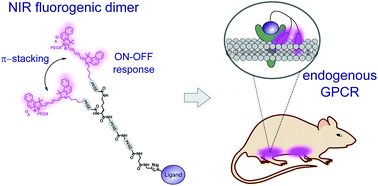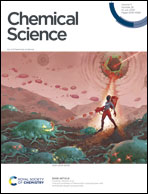A near-infrared fluorogenic dimer enables background-free imaging of endogenous GPCRs in living mice†
Abstract
Fluorescent probes are commonly used in studying G protein-coupled receptors in living cells; however their application to the whole animal receptor imaging is still challenging. To address this problem, we report the design and the synthesis of the first near-infrared emitting fluorogenic dimer with environment-sensitive folding. Due to the formation of non-fluorescent H-aggregates in an aqueous medium, the near-infrared fluorogenic dimer displays a strong turn-on response (up to 140-fold) in an apolar environment and exceptional brightness: 56% quantum yield and ≈444 000 M−1 cm−1 extinction coefficient. Grafted on a ligand of the oxytocin receptor, it allows the unprecedented background-free and target-specific imaging of the naturally expressed receptor in living mice.

- This article is part of the themed collection: Most popular 2019-2020 analytical chemistry articles


 Please wait while we load your content...
Please wait while we load your content...